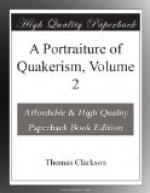In the first place St. Luke, and he is joined by all the other Evangelists, calls the feast now spoken of the passover. Jesus Christ also gives it the same name; for he says, “with desire I have desired to eat this passover with you before I suffer.”
Jesus Christ, according to St. Luke, took bread and broke it, and divided it among his disciples. He also took the cup, and gave thanks, and gave it among them. But this, the Quakers say, is no more than what the master of every Jewish family did on the passover night: nor, is it any more, as will have already appeared, than what the Jews of London, or of Paris, or of Amsterdam, or of any other place, where bread and wine are to be had, do on the same feast at the present day.
But though Jesus Christ conducted himself so far as other masters of families did, yet he departed from the formula of words that was generally used upon these occasions. For in the first place, he is described to have said to his disciples, that “he would no more eat of the passover, until it should be fulfilled in the kingdom of God;” and a little farther on, that “he would not drink of the fruit of the vine, till the kingdom of God should come; or, as St. Matthew has it, till he should drink it new with them in his father’s kingdom.”
By these words the Quakers understand, that it was the intention of Jesus Christ to turn the attention of his disciples from the type to the antitype, or from the paschal lamb to the lamb of God, which was soon to be offered for them. He declared, that all his passover suppers with them were in future to be spiritual. Such spiritual passovers, the Quakers say, he afterwards ate with them on the day of pentecost, when the spirit of God came upon them; when their minds were opened, and when they discovered, for the first time, the nature of his kingdom. And these spiritual passovers he has since eaten, and continues to eat with all those whose minds, detached from worldly pursuits and connexions, are so purified and spiritualized, as to be able to hold communion with God.
It is reported of him next, that “he took bread, and gave thanks, and brake it, and gave to his disciples, saying, this is my body which is given for you.”
On these words the Quakers make the following observations:—The word “this” does not belong to the word “bread,” that is, it does not mean that this bread is my body. For the word “bread” in the original Greek is of the masculine, and the word “this” is of the neuter gender. But it alludes to the action of the breaking of the bread, from which the following new meaning will result. “This breaking of the bread, which you now see me perform, is a symbol or representation of the giving, or as St. Paul has it, of the breaking of my body for you.”
In the same manner, the Quakers say, that the giving of the wine in the cup is to be understood as a symbol or representation of the giving of his blood for them.




